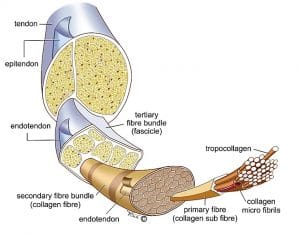Tendonitis, tendinosis and tendinopathy? What’s the difference and when will I get better?
There is a lot of misunderstanding when it comes to tendon injuries, with many confusing terms and sometimes contradicting advice on how best to treat them.
What do tendons do and how do they work?
We often think of tendons as merely a connection a muscle has to the bone, to allow it to transfer a pulling force, much like pulling on a string or rope. We have since discovered tendons to be a lot more complex! Their primary role is actually to store and release energy, much like a spring, to allow us to propel ourselves. This is particularly obvious with the Achilles tendon at the ankle when we are sprinting. It is responsible for much of the forward propulsion, and allows us move efficiently with less metabolic energy expenditure.
What happens when a tendon is injured?
A tendon is injured when there is a force exerted on it that exceeds what it is capable of withstanding. What we have found is that when there is damage to tendon tissue, that area of the tendon does not heal. Even when re-scanned long after the injury and once pain has settled and tendon function has restored, the tendon will still look the same on ultrasound.
Tendinopathy – This is a broad term to describe any pathology of a tendon.
Tendonitis – Refers to inflammation of the tendon, which is actually a less common cause of tendon pain than you might think! However the term is loosely used out of habit to described any tendon pain or pathology.
Tendinosis – This is non-inflammatory degeneration of collagen fibers in the tendon due to repetitive overloading and is a much more common cause of tendinopathy or tendon pain. As a result, they typically don’t respond that well to anti-inflammatories, and are best treated with rehabilitation exercises to strengthen the intact tendon tissue.
How are tendon injuries treated?
Studies have shown scans on individuals with even quite extensive tendon tissue damage, go on to be relative pain-free and high functioning with appropriate non-surgical treatment and rehabilitation. The key is, that even when there has been significant damage to part of the tendon, there is generally still a lot of good quality, functioning tendon tissue around it, and it is this part of the tendon that we are looking at strengthening and conditioning with our exercises, to allow it to operate at capacity.
It is not just a case of ‘stretching it out’ – in fact, in some cases this could actually cause further tissue damage and prolong your road to recovery. We need to use gradual strength and loading exercises to recondition the function of the tendon. Everyone’s injury will be slightly different, and require a tailored approach, so it’s best to see a health professional for proper advice and management.
In the case of a complete tendon rupture, then surgical intervention is required.
Our goal with rehabilitation exercises is to improve the capacity of the tendon to store and release energy, well above the daily demands that will be exerted upon it, thus reducing the risk of re-injury.
We see a lot of tendon injuries through the clinic, most commonly of the shoulder and hip region. A thorough physical examination is often enough for us diagnose the nature and severity of tendon injury, and develop a treatment plan to get you back to full function. In some cases we may decide to get an ultrasound or MRI to further assess the degree of tendon injury and rule out any other pathology. Treatment generally comprises gradual progression through a program of exercises designed to increase the load tolerance of the tendon, in combination with hands-on manual therapy to maintain pain-free range of motion through the region.
Feel free to contact us if you would like more information on tendon injuries, or if you would like to book a consultation, you can use our online bookings or phone on 9581 3331.



